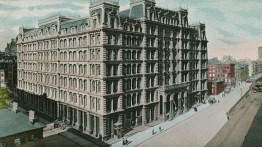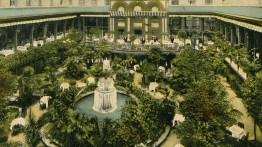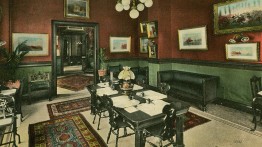Demolished Manhattan Hotels
Fri, Feb 10, 2023 12pm - Fri, Mar 10, 2023 5pm
This exhibition features postcards selected from the Architecture Archive’s Joseph Covino New York City Postcard Collection. Dating from the late 19th to mid-20th century, the collection is among the largest documenting New York City’s built environment. Its nearly 3,800 postcards were donated to the Architecture Archive between 1999 and 2003 by Joseph Covino, an avid postcard collector.
Originally presented in 2009 by Barb Choit, the Archive’s collections assistant from 2007 – 2010, the postcards shown here depict thirteen Manhattan hotels—from Astor House to the Hotel Piccadilly—that were built and demolished over the course of nearly 150 years. Organized chronologically by their construction date, these buildings now exist only as images.
Indeed, many of the collection’s postcards document no-longer-extant buildings, interiors, businesses, and public spaces. They record a city in constant flux, capturing several decades of urban development across all five boroughs, from the city’s piers, airports, subways, and armories, to its public parks, aquariums, monuments, and libraries. Some subjects, including hotels, restaurants, and museums, as well as Coney Island and the 1939 World’s Fair, are extensively documented, attesting to the diverse commercial and public interests that shaped both the subjects depicted and the medium of the postcard itself. In addition to recording the city’s evolving physical form, the postcards are also commercial artifacts marking the rise of consumer culture, the growth of middle-class tourism, and the development of publishing technologies that fostered their widespread distribution and explosion in popularity during the first decades of the 20th century.
The postcards are supplemented with photographs, several of which were taken by the Detroit Photographic Company (later known as the Detroit Publishing Company). Launched in the 1890s, the company acquired rights to the Swiss “photochrom” process of converting black-and-white images to color for the mass production of photolithographic postcards and prints. Enabled by the Private Mailing Card Act of 1898—congressional legislation that allowed private publishers to produce postcards—the Detroit Photographic Company reportedly offered ten to thirty thousand different views, printing up to seven million photochrom images per year. The images featured on many postcards from the collection are derived from Detroit Publishing Company photos.
Held in the Foundation Building's Third Floor Hallway Gallery. Open to Cooper Union students, faculty, and staff.
Exhibitions and events presented by The Irwin S. Chanin School of Architecture Archive are made possible by the New York State Council on the Arts with the support of the Office of the Governor and the New York State Legislature.
Located at 7 East 7th Street, between Third and Fourth Avenues







